Master your phone's low-light settings to capture vibrant concert shots. Frame performers with dramatic stage lighting for striking compositions. Capture crowd energy by positioning yourself strategically and waiting for peak moments. Time your shots perfectly by anticipating the flow of the performance. Experiment with burst mode to freeze dynamic action on stage. Use HDR for high-contrast scenes to balance bright lights and dark backgrounds. Edit your photos on-the-go to enhance and share immediately. These tricks will help you capture the excitement of live performances, but there's more to explore to truly elevate your concert photography game.
Master Low Light Settings
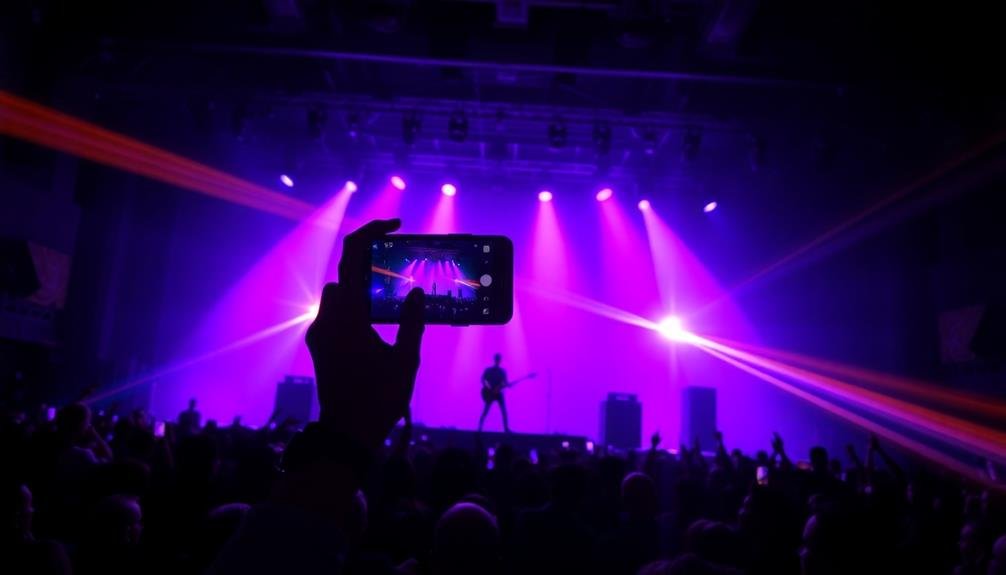
Concerts' dim lighting can be a photographer's nemesis, but you can turn it into your ally. Start by familiarizing yourself with your phone's manual or "pro" mode. This allows you to adjust ISO, shutter speed, and exposure compensation.
Boost your ISO to increase light sensitivity, but be cautious of introducing excessive noise. Experiment with slower shutter speeds to capture more light, but steady your hand or use a small tripod to avoid blur.
Many modern smartphones offer a dedicated night mode. Activate this feature to automatically optimize settings for low-light environments. It'll combine multiple exposures to create a brighter, clearer image.
Don't forget to disable your flash; it often ruins the ambiance and may be prohibited at venues.
Focus on bright spots on stage or colorful lighting effects. These elements can create enchanting compositions even in dim conditions.
If your phone has RAW capture capabilities, use it. RAW files retain more data, giving you greater flexibility when editing later.
Capture Crowd Energy
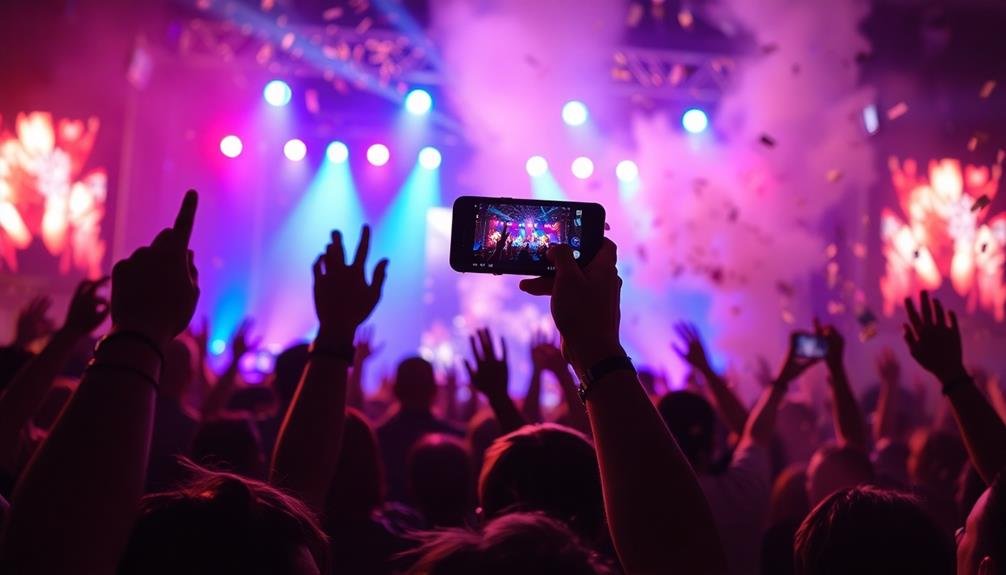
While mastering low-light settings is key, don't forget about the crowd's energy – it's often the heart of a concert experience.
To capture this vibrant atmosphere, position yourself strategically. Look for elevated spots that offer a wide view of the audience, like balconies or risers. From here, you can snap photos that showcase the sea of fans, their raised hands, and the collective excitement.
Timing is essential when photographing crowd energy. Wait for peak moments, such as when the crowd sings along to a popular song or during an encore. These instances often produce the most dynamic and emotionally charged shots. Use burst mode to capture a series of quick shots, increasing your chances of getting the perfect frame.
Don't shy away from using your phone's wide-angle lens if available. It's ideal for encompassing large crowds and conveying the scale of the event.
For a unique perspective, try capturing the crowd's reflection in sunglasses or other reflective surfaces. Finally, experiment with slow shutter speeds to create motion blur, visually representing the crowd's movement and energy in your photos.
Frame With Stage Lighting
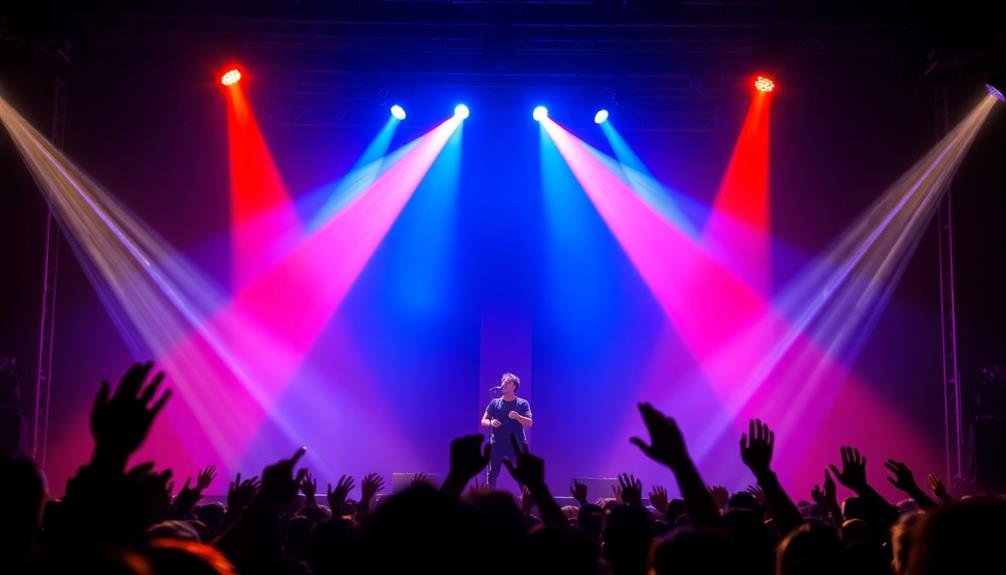
Harnessing stage lighting can transform your concert photos from ordinary to extraordinary. When you're framing your shots, look for dramatic lighting effects that can add depth and atmosphere to your images. Pay attention to colorful spotlights, strobes, and backlit silhouettes that create striking contrasts.
To make the most of stage lighting, try these techniques:
| Lighting Type | Photography Tip |
|---|---|
| Spotlights | Focus on illuminated performers |
| Backlighting | Capture dramatic silhouettes |
| Strobes | Use burst mode for varied effects |
| Color washes | Experiment with white balance settings |
| Laser shows | Incorporate geometric patterns in shots |
Don't be afraid to experiment with your phone's exposure settings. Slightly underexpose your shots to preserve the intensity of the stage lights and prevent blown-out highlights. If your phone has a "night mode" or "low light" setting, try using it to capture more detail in dimly lit scenes.
Time Your Shots Perfectly
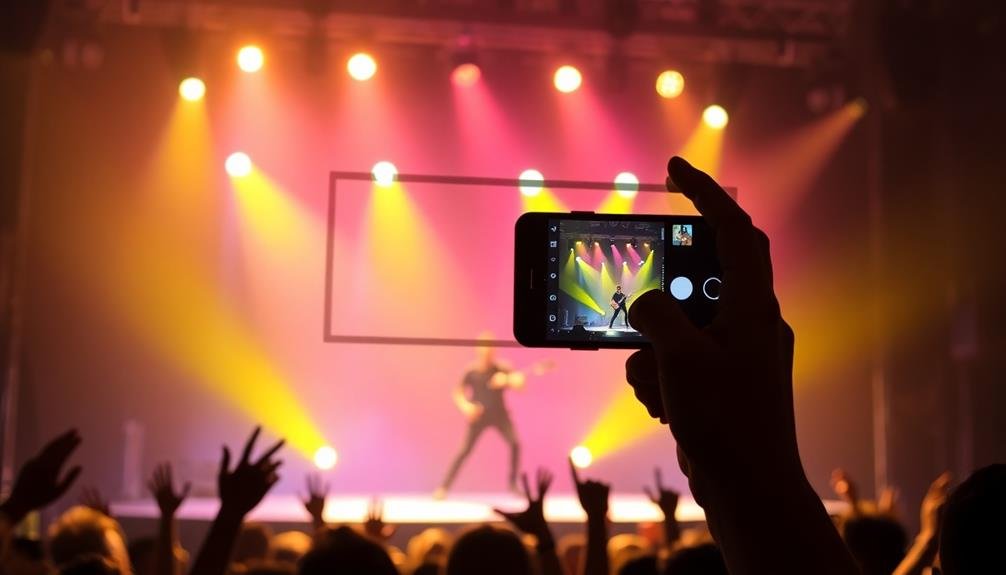
To capture the essence of a live performance, you'll need to anticipate key moments and be ready to snap.
Watch for crowd energy peaks and the artist's signature moves to immortalize the concert's highlights.
Using burst mode strategically can help you catch split-second actions, ensuring you don't miss that perfect shot.
Anticipate Key Performance Moments
The art of capturing perfect concert photos lies in anticipating key performance moments. As a concertgoer, you'll need to develop an intuitive sense of the performance's flow to predict when the most photogenic instances will occur.
Pay attention to the music's structure, looking for buildups that often lead to dramatic crescendos or visual spectacles.
Watch for cues from the performers themselves. Lead singers often have signature moves or gestures they repeat during key lyrics or chorus lines. Guitarists might leap or strike a pose during solos, while drummers may twirl their sticks or stand up for dramatic effect.
Keep an eye on lighting changes, as they often signal important moments in the show.
Study the band's setlist if possible, or familiarize yourself with their most popular songs. This knowledge will help you anticipate when crowd-pleasing hits are coming up, which often coincide with heightened energy and visual appeal.
Remember that encore performances typically feature some of the most dynamic moments, so save some battery power for the end.
Capture Crowd Energy Peaks
Concert photography isn't just about capturing the performers; it's equally important to document the crowd's energy. To capture those electrifying moments when the audience's excitement reaches its peak, you'll need to be alert and ready.
Watch for key song intros or chorus drops that typically elicit strong crowd reactions. You'll often see hands raised, people jumping, or crowd surfers emerging during these high-energy moments. Position yourself to capture both the stage and the audience in a single frame, if possible. This creates a more dynamic image that conveys the full concert experience.
Use burst mode on your phone to take multiple shots in quick succession. This increases your chances of capturing the perfect moment when the crowd's energy is at its zenith. Pay attention to lighting changes, as dramatic stage effects often coincide with crowd reactions.
Don't forget to look for individual expressions of excitement in the crowd. Close-up shots of passionate fans singing along or friends embracing can be just as powerful as wide crowd shots.
Use Burst Mode Strategically
Burst mode is your secret weapon for capturing the perfect concert shot. This feature allows you to take multiple photos in rapid succession, increasing your chances of getting that ideal moment.
To use burst mode effectively, anticipate the action and start shooting just before the peak moment you want to capture. When photographing performers, activate burst mode as they're about to jump, spin, or make dramatic gestures.
For crowd shots, use it when the audience is about to throw their hands up or during a crowd surf. Don't forget to experiment with burst mode during light changes or pyrotechnic effects.
After the burst, review your shots immediately and select the best ones. This technique is particularly useful in low-light conditions where individual shots might be blurry.
Remember, burst mode can quickly fill up your phone's storage, so be selective about when you use it. To access burst mode on most smartphones, simply hold down the shutter button.
Some phones may require you to enable this feature in the camera settings. Practice using burst mode before the concert to familiarize yourself with its operation and timing.
Experiment With Burst Mode
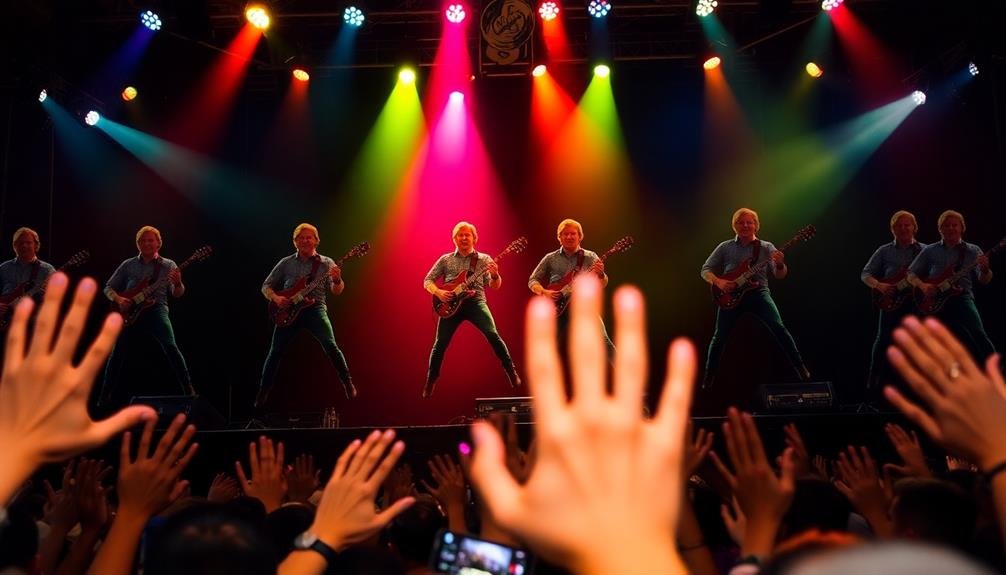
Burst mode is your secret weapon for capturing the most dynamic moments at concerts.
You'll snag a series of rapid-fire shots, increasing your chances of freezing that perfect jump or guitar solo.
Later, you can review and select the best images, ensuring you've preserved the most exciting and spontaneous parts of the performance.
Capture Action-Packed Moments
When you're trying to capture those high-energy moments at a concert, you'll want to experiment with your phone's burst mode. This feature allows you to take multiple shots in rapid succession, increasing your chances of getting the perfect action shot.
To use burst mode, simply press and hold the shutter button on your phone's camera app. Your device will capture a series of photos until you release the button. This technique is ideal for capturing dynamic moments like guitar solos, jumps, or crowd interactions.
After taking a burst of photos, review the sequence and select the best shots. Look for frames that capture peak action, interesting expressions, or unique lighting effects.
Don't be afraid to take multiple bursts throughout the concert to guarantee you don't miss any memorable moments.
Remember to anticipate the action and start your burst slightly before the expected peak moment. This way, you're more likely to catch the exact instant you want.
Also, consider your phone's storage capacity when using burst mode, as it can quickly fill up your device's memory.
Select Best Shots Later
The beauty of burst mode lies in its ability to capture multiple shots, giving you the freedom to select the best ones later. When you're at a concert, don't hesitate to use this feature liberally. Simply hold down your camera button to snap a rapid succession of photos. This technique is especially useful for capturing fast-moving performers or crowd reactions.
After the concert, take your time to review the burst shots. Look for the sharpest images, best expressions, and most dynamic moments. You'll often find gems you might've missed in real-time. Delete the blurry or less impressive shots to save storage space.
Here's a quick guide to using burst mode effectively:
| Scenario | Burst Duration | Tips |
|---|---|---|
| Solo performer | 2-3 seconds | Focus on facial expressions |
| Band performance | 3-5 seconds | Capture interactions between members |
| Crowd shots | 1-2 seconds | Look for enthusiastic reactions |
Preserve Spontaneous Performances
During live performances, spontaneous moments often create the most memorable experiences. To capture these fleeting instances, experiment with your phone camera's burst mode. This feature allows you to take multiple shots in rapid succession, increasing your chances of preserving that perfect moment.
To use burst mode effectively, activate it by holding down the shutter button or volume key, depending on your phone model. As the artist moves or interacts with the crowd, keep the burst mode running.
This technique is particularly useful for:
- Capturing a guitarist's mid-air jump
- Freezing the exact moment a drummer's stick hits the cymbal
- Catching the lead singer's passionate facial expression
- Documenting the crowd's synchronized reaction to a favorite song
After the show, you'll have a series of images to choose from, allowing you to select the most dynamic and emotionally charged shots. Remember to delete the unnecessary photos to save storage space.
Use HDR for Dramatic Scenes
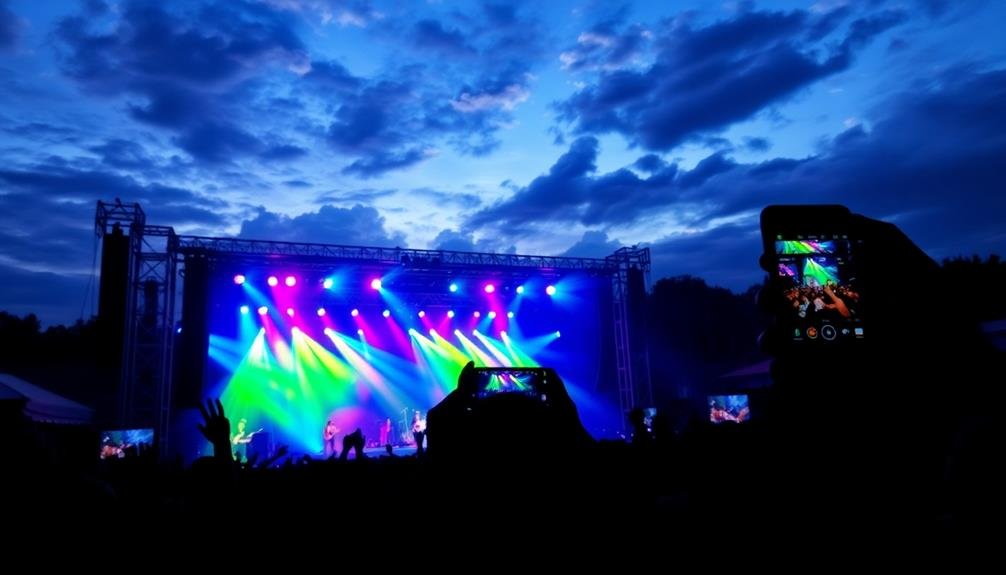
High Dynamic Range (HDR) can be your secret weapon for capturing dramatic concert scenes. This feature allows your phone to take multiple exposures and combine them, resulting in photos with balanced lighting and enhanced details.
When you're faced with stark contrasts between bright stage lights and dark backgrounds, HDR can help you capture both without losing information.
To use HDR effectively, steady your hand or use a small tripod to avoid blurring. Look for scenes with high contrast, such as backlit performers or dramatic lighting effects.
HDR works best when the subject isn't moving too quickly, so time your shots during slower moments or when the artist is relatively still.
Be aware that HDR may not always be the best choice. In low-light situations or for fast-moving subjects, it might create unwanted artifacts or ghosting effects.
Experiment with HDR on and off to see which produces better results for each specific scene. Remember to check your phone's settings, as some devices have different HDR modes or AI-enhanced versions.
Edit On-the-Go for Sharing
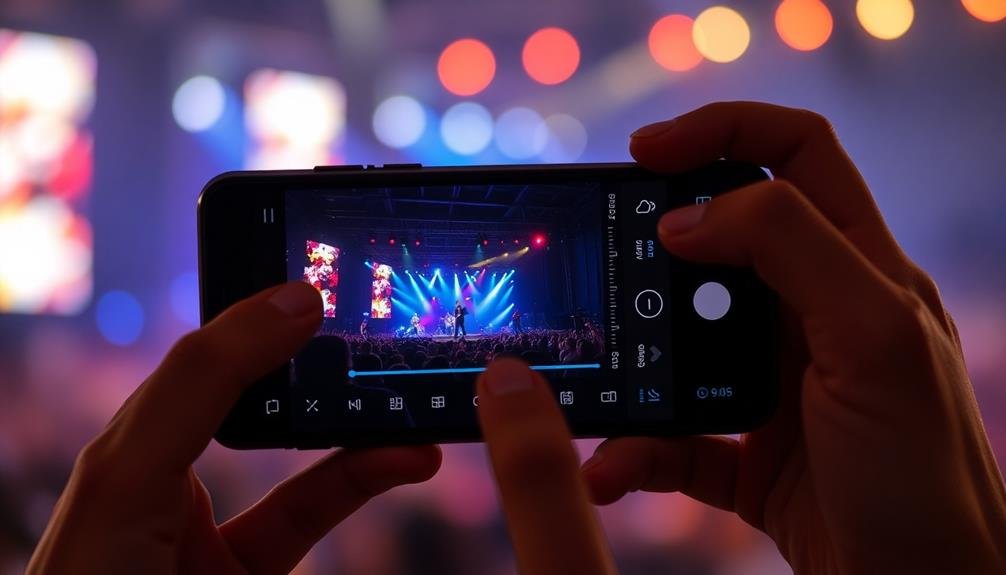
Capturing great concert photos is just the beginning. To truly make your shots stand out and share them instantly with friends or on social media, you'll need to master on-the-go editing. Most smartphones come equipped with powerful built-in editing tools, but don't hesitate to explore third-party apps for more advanced features.
Start by adjusting the basics: brightness, contrast, and saturation. These simple tweaks can dramatically improve your concert photos. Next, experiment with cropping to focus on the most impactful elements of your shot. Consider using filters to enhance the mood, but don't overdo it – you want to maintain the authentic concert atmosphere.
For an extra emotional punch, try these editing techniques:
- Boost shadows to reveal hidden details in dark areas
- Enhance vibrance to make colors pop without oversaturation
- Add a subtle vignette to draw attention to the center of the image
- Apply selective focus to emphasize the performer or crowd
Frequently Asked Questions
How Can I Protect My Phone From Damage During Crowded Concerts?
You can protect your phone at crowded concerts by using a sturdy case and screen protector. Keep it in a secure pocket or bag, use a wrist strap, and be mindful of your surroundings. Don't hold it up for extended periods.
Are There Any Legal Issues With Taking Photos at Concerts?
You should be aware of potential legal issues when taking concert photos. Many venues prohibit photography, and artists may have specific restrictions. Always check the event's policies and respect copyright laws to avoid any legal troubles.
What Accessories Can Enhance My Phone's Concert Photography Capabilities?
You'll improve your concert photos with these accessories: a clip-on lens for wider shots, a small tripod for stability, a portable battery pack for extended use, and a microfiber cloth to keep your lens clean.
How Do I Avoid Disturbing Other Concertgoers While Taking Photos?
Be considerate while capturing memories. Keep your phone low, avoid flash, and don't obstruct others' views. Use silent mode, turn down screen brightness, and take quick shots. Remember, you're there to enjoy the show too.
Can I Use My Phone's Flash for Concert Photography?
You shouldn't use your phone's flash at concerts. It's distracting to performers and other fans, and it won't improve your photos. Instead, rely on stage lighting and adjust your camera settings for low-light conditions. You'll get better results.
In Summary
You've now got the tools to capture unforgettable concert moments with your phone. Don't be afraid to experiment and find your unique style. Remember, it's not just about the perfect shot; it's about preserving the energy and emotion of the live experience. With practice, you'll be snapping pro-level photos in no time. So get out there, enjoy the music, and start creating stunning visual memories you'll cherish for years to come.

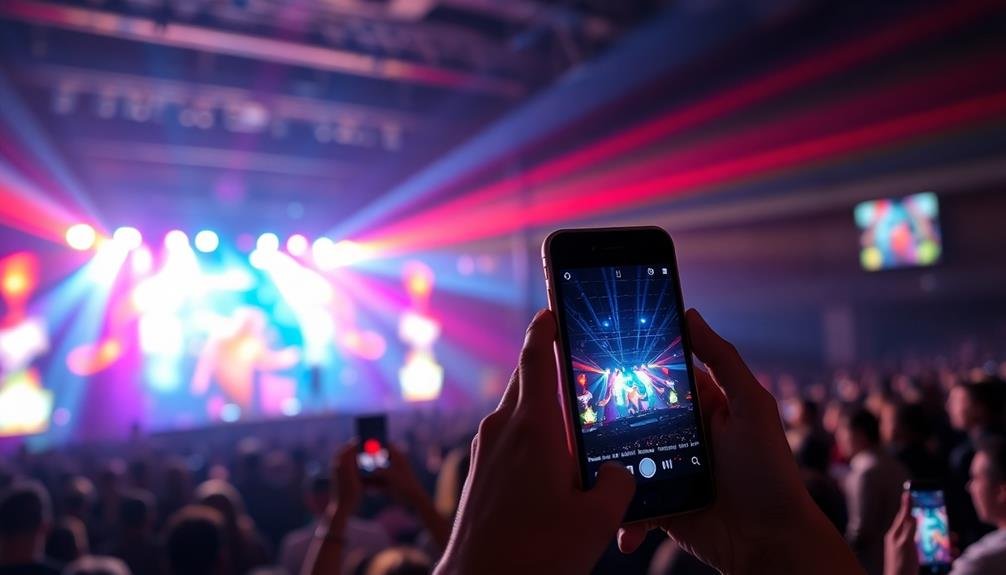



Leave a Reply